Rural Scotland Business Panel Survey October 2022
This report presents findings from the third Rural Scotland Business Panel Survey carried out in June and July 2022.
4. Growth
Key findings
When thinking about their own business, the factors most commonly associated with "growth" were an increase in sales or turnover (79%) and a growing customer base (74%).
Just over four in ten (43%) businesses were striving for growth, while the same proportion (43%) were content with their current level of performance. Around one in ten (13%) wanted to downsize.
The most common reasons for striving for growth were to make or increase profit (86%), to continually evolve (80%), to enhance resilience against economic uncertainty (78%) and to respond to changes in demand (77%).
The main reasons for wanting to retain current levels of performance were that the business was operating as planned (71%) and feeling content with financial performance (62%).
Among businesses that wanted to downsize, the top reason was that they were reaching retirement age (77%). This was followed by wanting to work less (63%), wanting to avoid stress (48%), increased costs (44%) and economic uncertainty (35%).
Growth characteristics
When thinking about their own business, the factors most commonly associated with "growth" were an increase in sales or turnover (79%) and a growing customer base (74%).
Around half of businesses said they associated growth with new products or services (48%), followed by 46% saying creating new jobs and 42% saying expanding into new markets. A quarter said new or bigger premises (24%), while around a fifth said merging with or acquiring other businesses (20%) and accessing and using external finance (18%) (Figure 4.1).
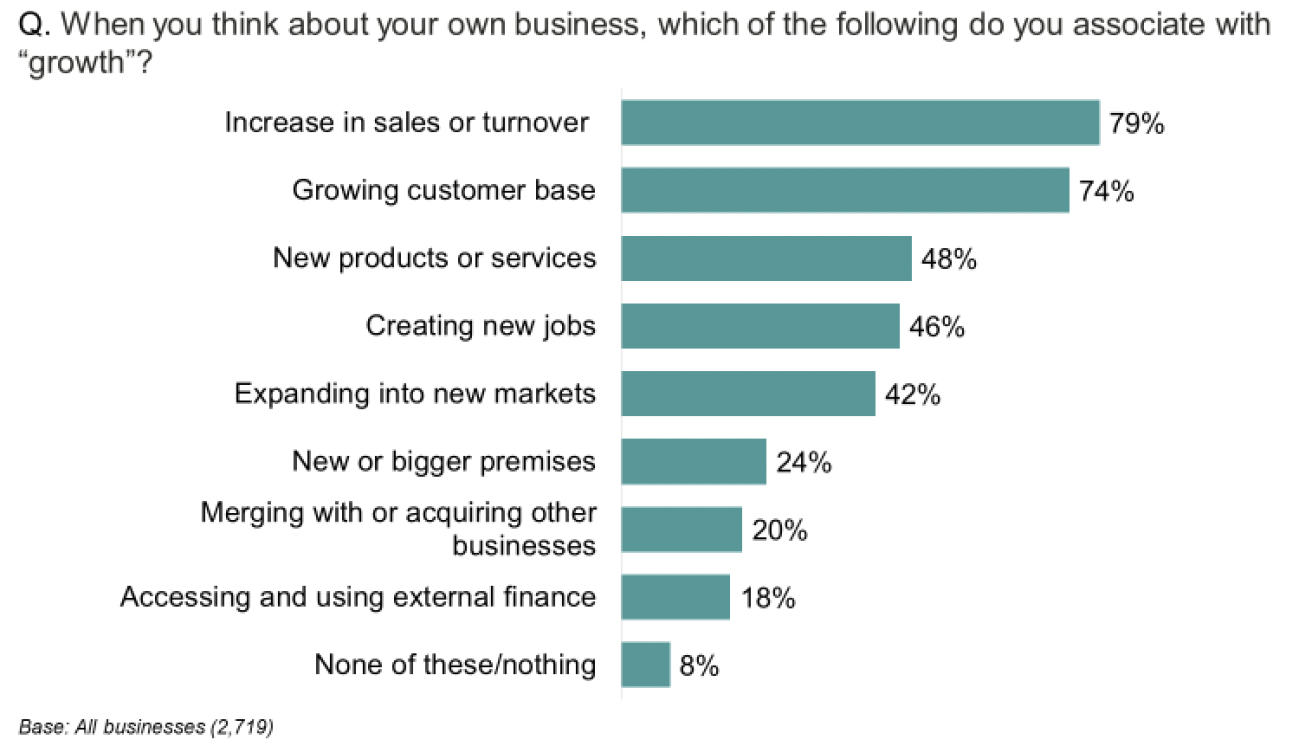
Variation in characteristics
Businesses in the Highlands and Islands were more likely than average to associate growth with creating new jobs (50%), expanding into new markets (45%), newer or bigger premises (27%) or using external finance (22%).
Those in the South of Scotland were more likely to say expanding into new markets (45%) and using external finance (23%).
The following types of business were more likely than average to associate specific factors with growth:
- Creative industries – new products or services (60%) and expanding into new markets (55%).
- Food and drink – accessing and using external finance (25%).
- Those operating above pre-pandemic levels – increase in turnover (86%), growing customer base (82%), creating new jobs (53%) and new/bigger premises (33%).
Further, the following were more likely than average to mention each factor:
- businesses with 5-10, 11-24 or 25+ staff,
- those in small towns and peripheral urban locations,
- those striving for growth, and
- those either actively seeking or open to seeking out new ways of doing things.
Growth aspirations
Just over four in ten (43%) businesses were striving for growth, while the same proportion (43%) were content with their current level of performance. Around one in ten (13%) wanted to downsize. Growth aspirations were in line with those seen in the previous wave in February/April 2022, when 43% wanted to grow, 45% were content and 11% wanted to downsize (Figure 4.2).
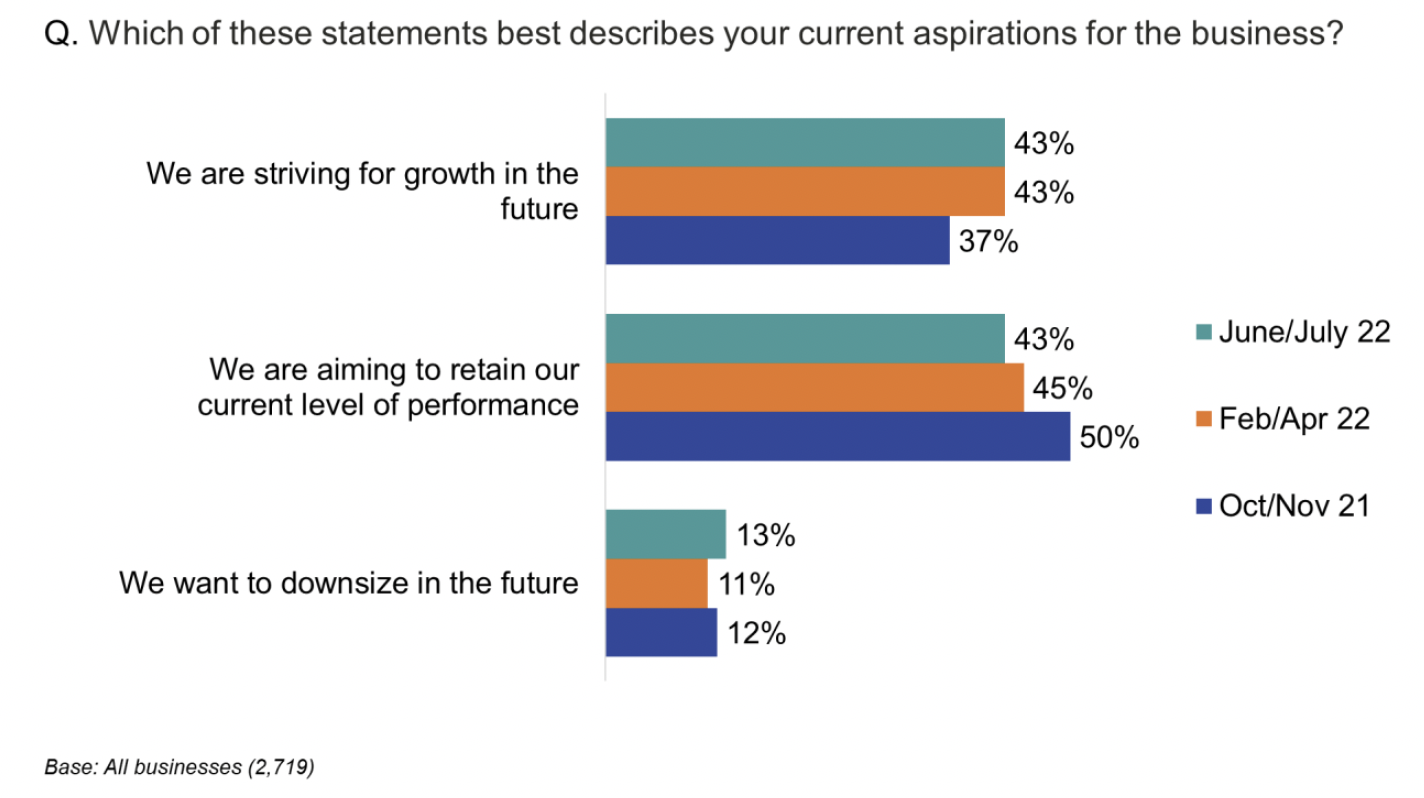
Variation in growth aspiration
Growth aspirations were similar across the three regions. However, those in the South of Scotland were more likely than average to say they wanted to retain their current level of performance (47%), in line with February/April 2022 when that figure was 49% (Figure 4.3).
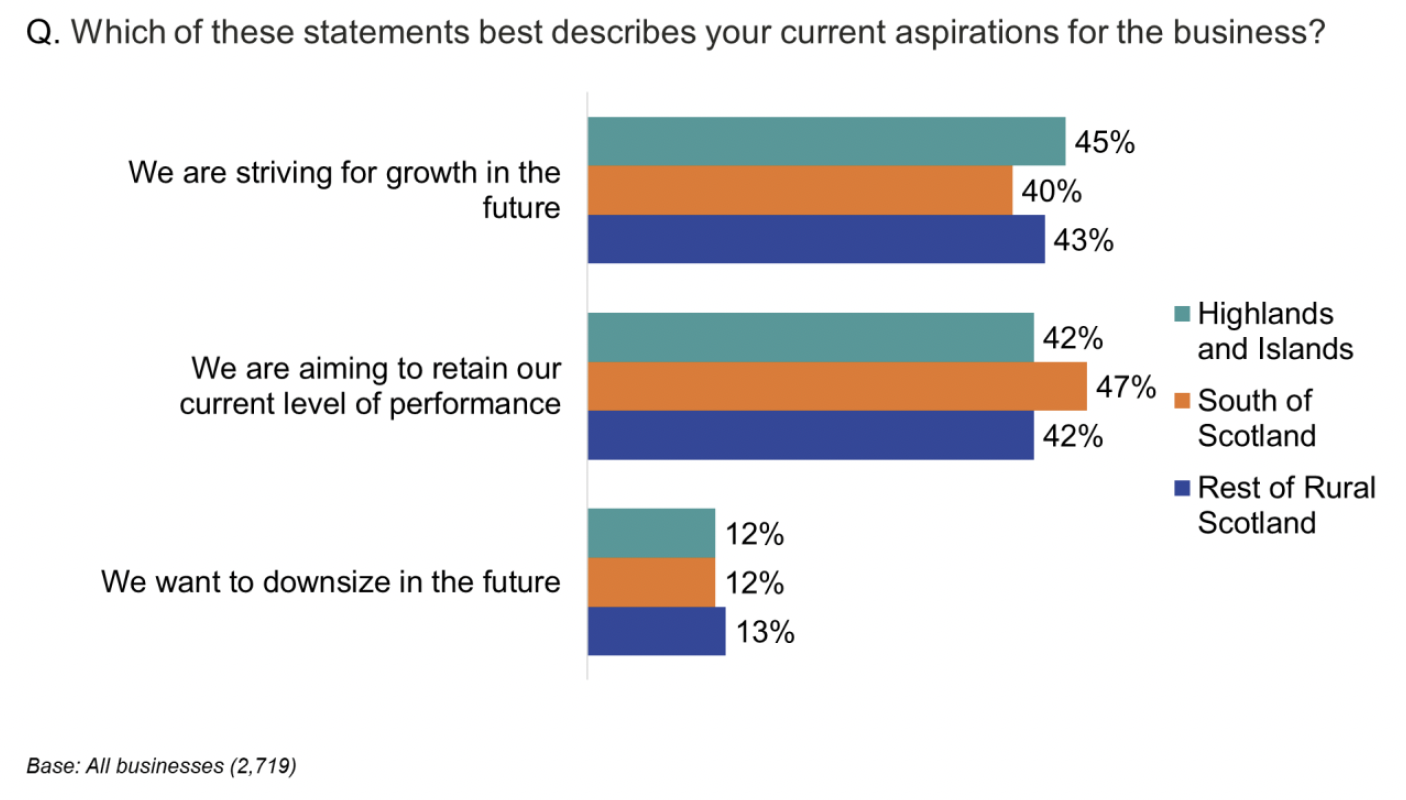
Businesses more likely than average to strive for growth included:
- tourism (53%),
- those with 5-10 (57%), 11-24 (64%) and 25+ staff (76%),
- in small towns and peripheral urban locations (49%),
- operating above pre-pandemic levels (56%), and
- behind where they wanted to be on productivity (47%).
Businesses more likely than average to want to retain current level of performance included:
- food and drink (54%),
- those with 0-4 staff (46%),
- in accessible rural areas (49%), and
- operating in line with their pre-pandemic levels (52%).
Businesses more likely to want to downsize included:
- creative industries (21%) and food and drink (15%),
- those with 0-4 staff (16%),
- those in remote rural areas (15%), and
- operating below their pre-pandemic levels (17%).
Motivations driving growth aspirations
Reasons for wanting to grow
The most common reasons for striving for growth were to make or increase profit (86%), to continually evolve (80%), to enhance resilience against economic uncertainty (78%) and to respond to changes in demand (77%). This was followed by enhancing skills and expertise (72%), supporting community sustainability (69%) personal or corporate ambition (67%) and to attract/retain staff (66%). Half said legacy and succession planning, while just over a quarter mentioned selling or transferring the business (Figure 4.4).
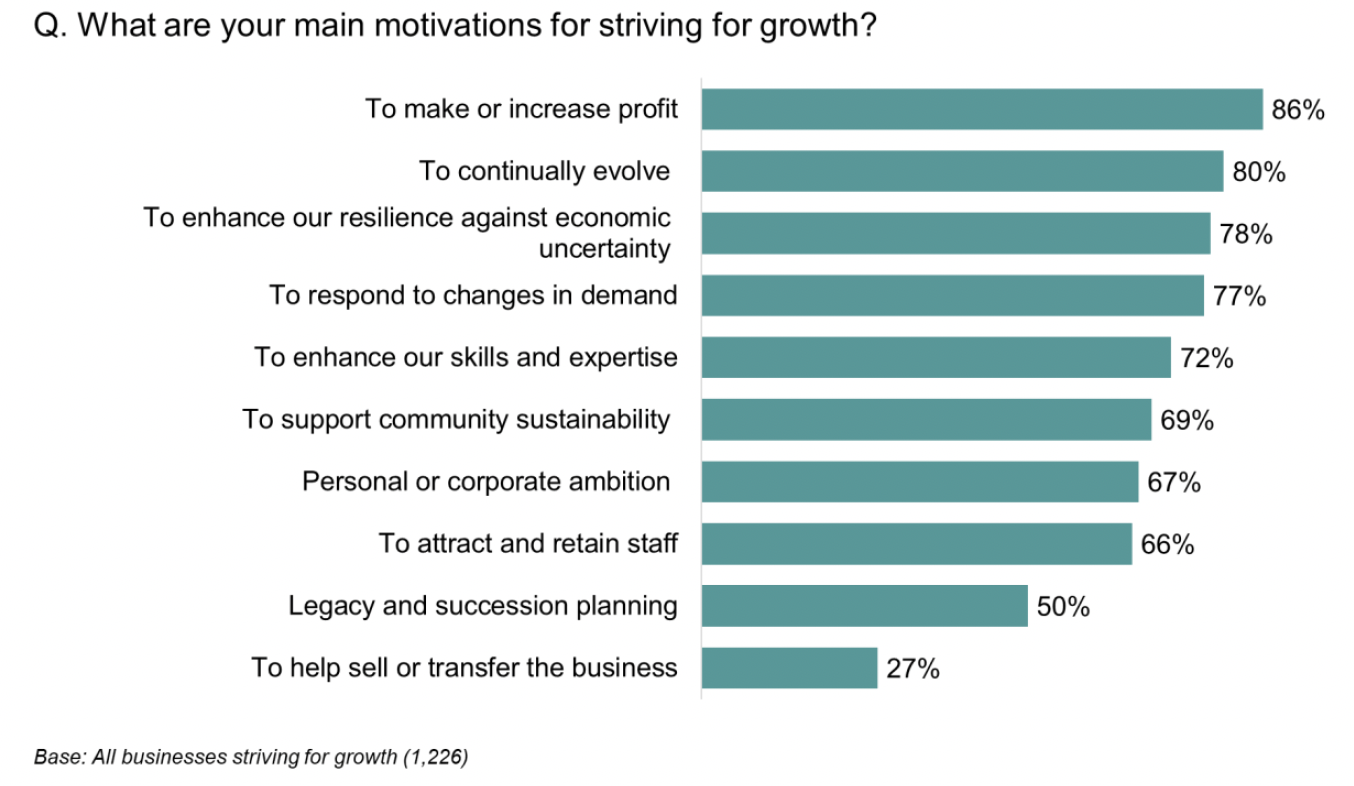
These motivations for growth can be grouped into four broad themes, as outlined below:
- Business resilience (91%) (including to continually evolve, enhance resilience, or response to changes in demand).
- Profit and corporate ambition (91%) (including to make or increase profit, or personal or corporate ambition).
- People and skills (80%) (including to support community sustainability, enhance skills and expertise, or attract and retain staff).
- Future and legacy (58%) (including legacy and succession planning or to help sell or transfer the business).
Variation in growth motivations
Types of businesses that were more likely to give responses under the four broad categories of motivations are outlined below.
Profit and corporate ambition:
- Businesses in South of Scotland (95% vs 91% overall).
Business resilience:
- Operation levels similar to pre-pandemic (94%)
People and skills:
- Those with 11-24 staff (90% vs 80% overall)
- Island locations (87%) – especially in relation to supporting community sustainability (84% vs 69% overall).
Future and legacy:
- Businesses in the Highlands and Islands (63% vs 58% overall)
- Food and drink businesses (69%)
- Operation levels similar to pre-pandemic (63%)
- In line or above where they wanted to be on adoption of technology (61%).
Reasons for wanting to retain current level of performance
The main reasons for wanting to retain current levels of performance were that the business was operating as planned (71%) and feeling content with financial performance (62%). Other reasons included economic uncertainty (54%), to reduce or avoid stress (52%), to reduce or avoid debt or financial risk (44%), and a lack of time (34%) or staff (33%) to make changes (Figure 4.5).
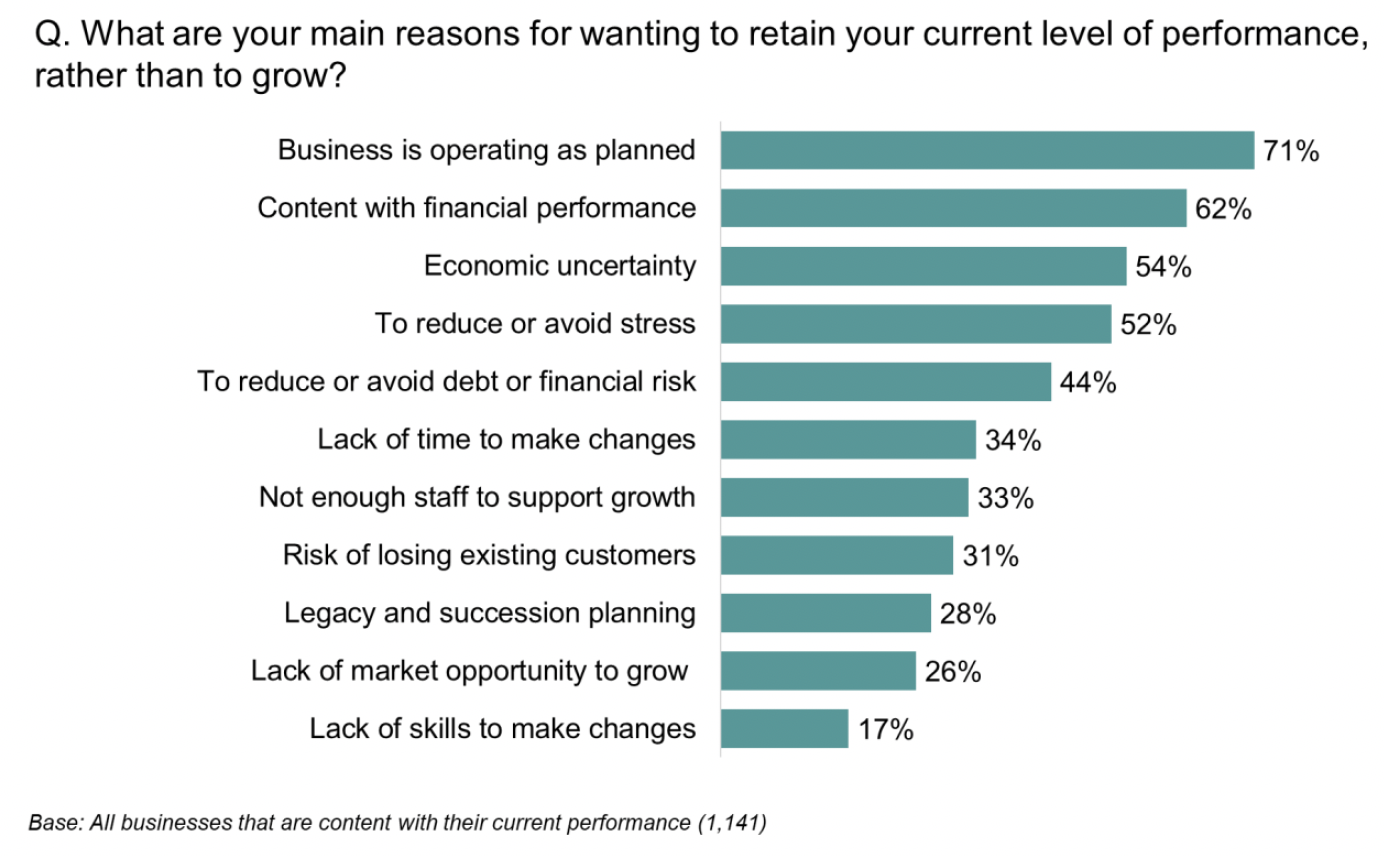
These motivations for retaining current level of performance can be grouped into five broad themes, as outlined below:
- Being content with performance (78%) (including saying the business was operating as planned or content with financial performance).
- Avoiding stress or risk (66%) (including to reduce or avoid stress, debt or financial risk, or risk of losing customers).
- Market conditions (59%) (including economic uncertainty, or lack of market opportunity to grow).
- Lack of capacity (51%) (including not enough staff, lack of time and lack of skills to make changes).
- Legacy and succession planning (28%).
Variation in motivations to maintain current level of performance
Types of businesses that were more likely to give responses under the five broad categories of motivations are outlined below.
Being content with performance:
- Remote rural businesses (82% vs 78% overall)
- Operating above or in line with pre-pandemic levels (each 85%)
- In line with or above where they wanted to be on productivity (84%), competitiveness (82%), skills performance (80%) or adoption of technology (80%).
Avoiding stress or risk:
- Behind where they wanted to be on adoption of technology (77%) and productivity (72% vs 66% overall).
Market conditions:
- South of Scotland (64%)
- Food and drink (68%)
- Operating below pre-pandemic levels (73%)
- Impacted by COVID-19 (68%), the Russia-Ukraine conflict (68%), EU Exit (64%), and rising costs (63%)
- Behind where they wanted to be on competitiveness (81%), productivity (72%), or skills development (70%).
Lack of capacity:
- Highlands and Islands (54%)
- Remote rural businesses (57% vs 51% overall)
- Behind where they wanted to be on skills development (72%), adoption of technology (67%) or productivity (60%).
Legacy and succession planning:
- Food and drink (37% vs 28% overall)
- Remote rural businesses (33%)
- Impacted by the Russia-Ukraine conflict (38%) and EU Exit (35%)
- Behind where they wanted to be on skills performance (39%).
Reasons for wanting to downsize
Among businesses that wanted to downsize, the top reason was that they were reaching retirement age (77%). This was followed by wanting to work less (63%), wanting to reduce or avoid stress (48%), increased costs (44%) and economic uncertainty (35%) (Figure 4.6).
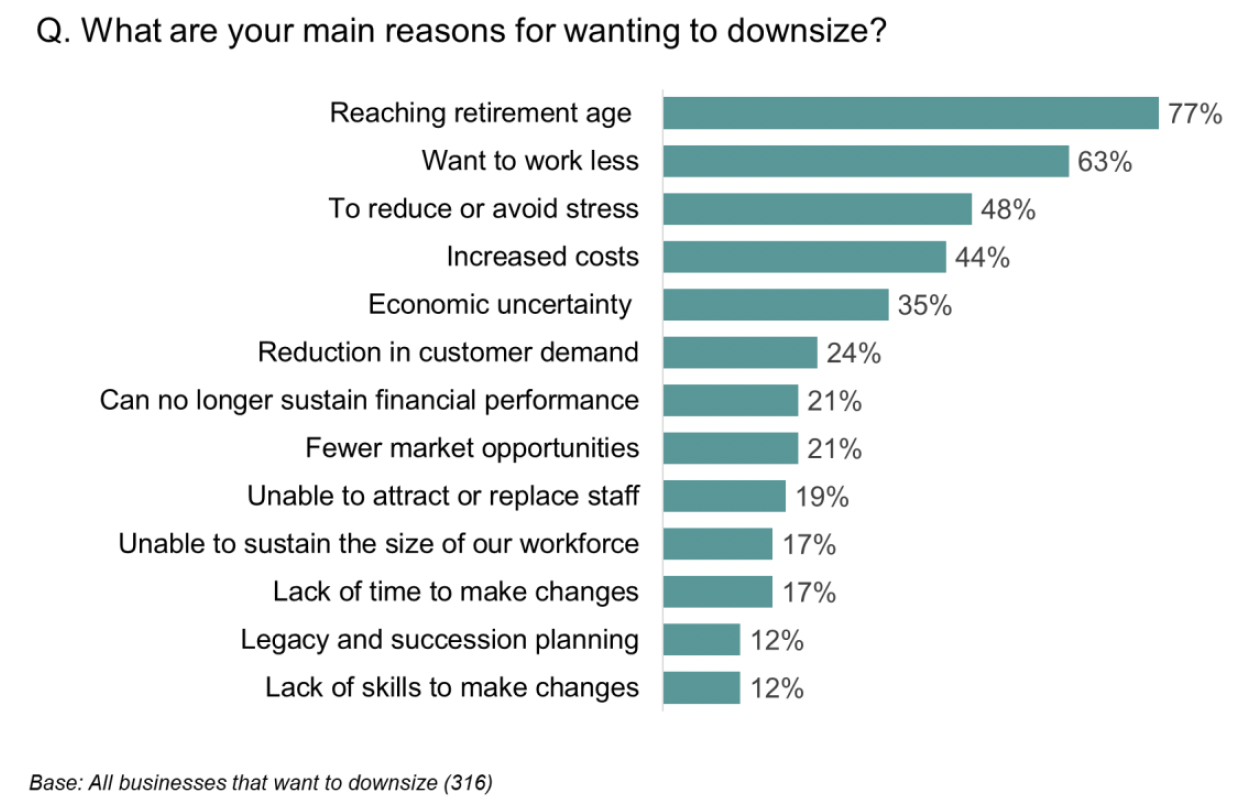
These motivations for wanting to downsize can also be grouped into five broad themes, as outlined below
- Lifestyle (91%) (including reaching retirement, wanting to work less or wanting to reduce or avoid stress).
- Finance and performance (50%) (including increased costs, no longer able to sustain financial performance, or unable to attract or replace staff).
- Market conditions (44%) (including economic uncertainty, reduction in customer demand or fewer market opportunities).
- Lack of capacity (31%) (including lack of time, lack of skills and being unable to sustain the size of the workforce).
- Legacy and succession planning (12%).
Variation in motivations for wanting to downsize
Types of businesses that were more likely to give responses under the five broad categories of motivations are outlined below.
Lifestyle:
- Those confident in their future viability (93% vs 91% overall).
Finance and performance:
- Food and drink (63% vs 50% overall)
- Behind where they wanted to be on productivity (73%), competitiveness (63%) or adoption of technology (62%).
Market conditions:
- Those in small towns and peripheral urban locations (52% vs 44% overall)
- Operating below pre-pandemic levels (57%)
- Impacted by COVID-19 (52%) or rising costs (50%)
- Behind where they wanted to be on productivity (65%).
Lack of capacity:
- Nongrowth sector (38% vs 31% overall)
- Impacted by rising costs (35%)
- Behind where they wanted to be on productivity (44%) or skills performance (49%).
Legacy and succession planning:
- Food and drink (20% vs 12% overall)
- Highlands and Islands businesses (19%)
- Behind where they wanted to be on productivity (22%).
Contact
Email: socialresearch@gov.scot
There is a problem
Thanks for your feedback